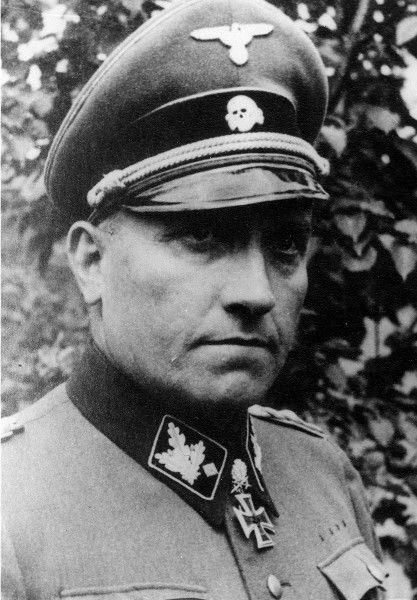Prieß, Hermann (Waffen SS)
- Date of birth:
- May 24th, 1901 (Marnitz/Mecklenburg-Schwerin, Germany)
- Date of death:
- February 22nd, 1985 (Ahrensburg/Schleswig-Holstein, Germany)
- Service number:
- SS-Nr.: 113.258 // NSDAP-Nr.: 1.472.296
- Nationality:
- German
Biography
Hermann August Friedrich Prieß / Priess
Promotions:
24th October 1944 : General des I. SS-Panzerkorps
24th April 1944 : SS-Gruppenführer / Generalleutnant der Waffen-SS;
7th August 1944 : General des XIII. SS-Armeekorps
15th Juli 1943 : SS-Brigadeführer und Generalmajor der Waffen-SS
28th April 1943 : SS-Oberführer
26th February 1943 : chief of the 3.SS-Pz.gren.-Div. „Totenkopf"
21st June 1941 : SS-Standartenführer
1st August 1940 : SS-Obersturmbannführer - Kommandeur of the Art.-Reg.
12th. June 1939 : Chief of the newly created II. Abteilung of the Art.-Reg. of the SS-Verfügungsdivision
20th April 1939 : SS-Sturmbannführer
1934 : SS-Hauptsturmführer - Chef der 13. Kompanie der SS-Standarte „Germania"
22th January 1919 : entered the Heer and served in the Freikorps „von Brandis" in the Baltikum
Do you have more information about this person? Inform us!
- Period:
- First World War (1914-1918)
- Awarded on:
- June 3rd, 1919
- Period:
- First World War (1914-1918)
- Awarded on:
- 1934
- Period:
- Second World War (1939-1945)
- Awarded on:
- September 22nd, 1939
- Period:
- Second World War (1939-1945)
- Awarded on:
- October 15th, 1939
- Period:
- Second World War (1939-1945)
- Period:
- Second World War (1939-1945)
- Rank:
- SS-Standartenführer (Colonel)
- Unit:
- Kdr, SS-Totenkopf-Artillerie-Regiment, SS-Division "Totenkopf", Waffen-SS
- Awarded on:
- January 6th, 1942
received for the defense attitude of his regiment in hte area of Demjansk.
- Period:
- Second World War (1939-1945)
- Awarded on:
- 1942
- Period:
- Second World War (1939-1945)
- Awarded on:
- 1942
- Period:
- Second World War (1939-1945)
- Rank:
- SS-Oberführer (Brigade General)
- Unit:
- Kommandeur, SS-Totenkopf-Artillerie-Regiment, SS-Panzergrenadier-Division "Totenkopf", Waffen-SS
- Awarded on:
- April 28th, 1943
“When the Russians closed the ring around Demyansk on the 03.02.1942, SS-Oberführer Prieß took over command of all Artillerie Batterien that were at the disposal of Gruppe Eicke.
In the weeks that followed the Russians launched many attacks in the bitter cold with massive quantities of men and materiel. However SS-Oberführer Prieß was able to direct his handful of batteries with both prudent foresight as well as lightning-swift responsiveness, and thanks to this it was possible to repeatedly smash the opposing attacks.
Whether it was in combat against enemy tanks (which had to be engaged with direct artillery fire due to a shortage of other defensive weapons) or in the elimination of enemy infantry that had penetrated the line, SS-Oberführer Prieß could always be found at the most endangered points of the defense. From here he inspired his men to achieve great things by way of his own personal example.
This proved to be of extreme importance, as the ragtag of available friendly infantry would not have been able to hold off the overwhelming enemy forces without reliable support from our own artillery.
Gruppe Eicke was ultimately able to hold its 41 km long sector without yielding a foot of ground to the Russians, and so ‘Fortress Demyansk’ was held under the most trying of frontline conditions. This was a success of decisive importance, and such a feat was thanks in no small part due to the heroic courage and leadership of SS-Oberführer Prieß. This achievement simultaneously constituted the basis for the eventual relief of the encircled troops at Demyansk.
I ask that SS-Oberführer Prieß be awarded the Knight’s Cross to the Iron Cross in recognition of his decisive success.”
- Period:
- Second World War (1939-1945)
- Awarded on:
- 1943
- Period:
- Second World War (1939-1945)
- Rank:
- SS-Brigadeführer / Generalmajor der Waffen-SS (Brigadier)
- Unit:
- Kommandeur, SS-Panzergrenadier-Division "Totenkopf", Waffen-SS
- Awarded on:
- September 9th, 1943
“The inspiring example of SS-Brigadeführer Prieß is largely responsible for the outstanding battlefield achievements [of his Division] in both attack and defense, and in particular the resounding defensive success of the 02.09.1943 (which saw 72 enemy tanks destroyed). He is the lead fighter of his brave Division.”
297th Award.
- Period:
- Second World War (1939-1945)
- Rank:
- SS-Brigadeführer / Generalmajor der Waffen-SS (Brigadier)
- Unit:
- Kommandeur, 3. SS-Panzer-Division "Totenkopf", Waffen-SS
- Awarded on:
- April 24th, 1944
“For quite some time now I have known SS-Brigadeführer Prieß (commander of the 3. SS-Pz.Div. ‘Totenkopf’) to be an especially decisive and battle-hardened leader. During the most recent round of combat he has particular distinguished himself in the area Balta-Birsula. In this time his Division was widely scattered, enveloped on both flanks and cut off from its rearward connections. However his clear leadership and independent decisions on this battlefield proved to be major factors that enabled the prolonged holding of the Balta—Odessa railway line. This in turn facilitated the withdrawal of those elements of both the Korps and the neighbouring Armee located further to the east.
He consistently directs his battles from the foremost line, and from here he maintains a firm grip over his command whilst also providing an outstanding example for his troops.”
65th Award.
Sources
- Photo 1: Willi Schumacher Collection
- - FELLGIEBEL, W.P., Elite of theThird Reich, Helion & Company Limited, Solihull, 2003.
- MOONEY, PETER, Waffen-SS Knights and their Battles, Schiffer Publishing, Ltd., 2012.
- MOONEY, PETER, Waffen-SS Knights and their Battles, Schiffer Military History, 2016.
- MOONEY, PETER, Waffen-SS Knights and their Battles, Schiffer Publishing, Ltd, 2010.
- PATZWALL, K. & SCHERZER, V., Das Deutsche Kreuz 1941-1945, Band II, Verlag Klaus D. Patzwall, Norderstedt, 2001.
- SCHNEIDER, J.W., Their Honor Was Loyalty!, Bender (R.James) Publishing, 1993.
- das-ritterkreuz.de
- Information from death certificate
- Microfilm Publication A3343. US National Archives
























